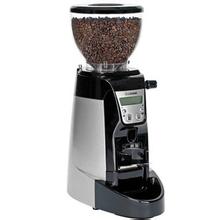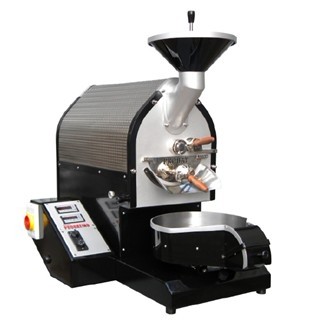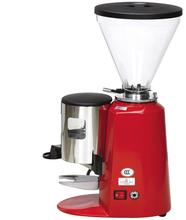Coffee grinder: the difference and selection between Robur and its cone knife Royal and its flat knife

There are many kinds of grinders on the market. From manual to electronically controlled tapered blades. But for espresso, the grinder is the most demanding. That's why.
First talk about two basic concepts, insufficient extraction, that is, the flow of water through the coffee powder is too fast, or the temperature is too low to fully extract the flavor of coffee.
Excessive extraction, on the contrary, coffee water stays in coffee powder for too long, or the water temperature per unit time is too high, resulting in coffee flavor or other flavor over-extraction.
Keep looking at the grinder.
The problem of uniform thickness of A Powder
First of all, espresso is made at 9 atmospheres. Therefore, the pressure of water is very high, and the gap between coffee powder must be very small. Otherwise, the unimpeded flow of water under high pressure between very coarse powder particles will result in insufficient extraction.
Secondly, because of the high temperature and high pressure extraction, any flavor will be magnified. If you use a non-Italian grinder to grind, the size of the powder is very different, which will cause excessive extraction of some coffee powder (small particles) and insufficient extraction of some coffee powder (large particles), so the resulting flavor is easy to produce miscellaneous smell.
But is it always good to have a consistent coffee powder?
This issue was hotly discussed about a few years ago.
Because at that time, apart from the difference in rotational speed between cone blades and blades (which will be mentioned later), many people began to wonder why the coffee tastes different between the two. In blind measurement, in the blind measurement of similar cutter head size (robur and royal), the conical knife robur will be better than the flat knife royal? And what's even more surprising is
Robur and its conical knife
Royal and its flat knife
In fact, the particle uniformity produced by the cone knife is far worse than that of the flat knife!
To explain this problem, you can compare it with the example of steak.
Unlike Chinese food, fried steak is layered, often well-done on the outside, half-done on the inside, and even bloody. But the advantage is that the taste is rich (complex), which can be superimposed layer by layer.
Similarly, coffee, like red wine as an acquired taste food, can not only be achieved through the variety of beans, mixed beans or baking (temperature curve, happy Vs slow heat, light baking Vs deep baking), but also through the grinder to produce a certain degree of uneven to reflect its rich taste.
Of course, there must be a range of such differences, because excessive differences will give rise to the problems of both over-extraction and under-extraction. In this category, I have seen the data show that the particle size is about 20% and 30%.
B the problem of grinding speed and heat energy
From raw beans to roasting, to grinding into powder, to making coffee. The closer to the finished product, the more "fragile" the coffee is. As long as the raw beans are properly stored, there will be no problem with them for a few months. Roasted coffee beans had better be finished within 3 weeks. If it is extracted under low pressure, one week is the best life cycle. If it is made of coffee, it will lose 50% of its fragrance in less than two minutes.
The grinding process of the grinder will produce a lot of heat. Ground coffee is easy to oxidize and volatilize when exposed to air. (this is also the reason why coffee beans are ground.) therefore, the heat generated by the speed of the grinder has a considerable impact on coffee. In other words, the slower the speed of coffee, the less heat will be generated, and eventually the rate of coffee oxidation will be reduced.
However, there is a paradox: "if the speed is slow, then the speed of powder will be slow." If the coffee shop is busy, don't you have to use a high-speed grinder? " Yes, but another way to achieve high output and low speed is to use a large diameter blade. Due to torque, grinding can be completed quickly even if the rotational speed is very low. For example, the big cutterhead of mazzer's current flagship product, robur,73mm, can basically produce 20g of powder in about 4 seconds, while the rotational speed is as low as 450RPM (it takes about 20-30 seconds for Mazzer's supper jolly 1500RPM to produce 20g).
It has been mentioned that the speed of the grinder has two effects on coffee, one is the speed of the powder itself, and the other is the heat generated. In fact, there is also a question about operation. Although the coffee powder is fast and can serve the public in a timely manner, I personally do not recommend buying a high-end high-speed grinder if it is not a very busy coffee shop. Because the waste of powder is quite large. This kind of waste is mainly reflected in several aspects:
1. A good coffee shop, a good barista, if he doesn't make coffee for a period of time, he will clear the powder every time he starts to make coffee, thus removing the coffee powder clogged in the powder channel. Often, the more efficient the grinder is, the more powder will be accumulated, and the more waste will be caused.
two。 Often the faster the grinder pulverizes, the better skills are needed to prevent waste.
What I want to emphasize here is that I take whether I can make 200 cups of coffee a day as whether the coffee shop is busy, that is, about 2.5-3kg of coffee beans a day. At the same time, it should be mentioned that the fast grinder can adjust the powder quantity more accurately, which will be detailed in the next chapter.
C manual Vs electric or powder quantity control problem
About 3-4 years ago, when the electronic version of robur appeared, many people cheered for a time, because when the timing was controlled at 0.05s, 20g of powder could be produced in less than 4 seconds, which seemed to mean that a truly accurate and efficient grinder had been developed.
There has never been a tendency to belittle electronic control. In fact, I personally have a robur e grinder. However, what I have found is that the over-reliance on electronic control is very serious, both at home and abroad.
First of all, let's look at the principle of electronic control.
It's simple, by timing. The running time is controlled in the unit of 0.05 seconds, thus the control of powder quantity is completed.
Reality:
Experiments have been done, the error can be as high as 0.8g when powdered for 5 times at the same time.
What kind of concept is this?
Only 0.5g of powder is equivalent to a double handle, which can completely change the flow rate and flavor of espresso. In the http://www.douban.com/note/177888288/ flavor evaluation, I only need to hit pressed powder one more time, the amount of powder can be about 0.3g more, and the fullness of the coffee will be significantly improved.
Therefore, the topic here is not that the robur electronic control board is not good, but that the electronic control board does not mean that you can rely too much on the accuracy of electronic control. You still need to fine-tune it through the powder distribution link.
Secondly, the electronic control board also has a more troublesome is to adjust the flow. Because when the thickness is adjusted, the speed of powder production in the same unit time is not the same. Therefore, after the thickness is adjusted, the time of powder production should be adjusted accordingly. I won't talk about this in detail here for the time being.
Of course, the electronic control board is not useless. The biggest advantage, I personally think, is to give up the powder bin and reduce the residual powder as much as possible. In addition, due to the abandonment of the powder bin, the coffee powder falls vertically, which avoids the waste of powder to a certain extent.
If the electric control board is not a tool that can be over-relied on, then the grinder of the hand control board still has a very competitive advantage even today. Through reasonable operation, the amount of powder can still be accurately controlled. This point will also be discussed in detail in the next chapter.
End
The grinder has an important effect on both baristas and coffee. The training of high-end baristas abroad is closely related to the grinder. This chapter can only briefly talk about the parameters of the grinder. But the points mentioned do not emphasize which kind of grinder is the best one. More importantly, how these characteristics of the grinder affect coffee. Of course, these parameters also influence each other.
Source: network
Important Notice :
前街咖啡 FrontStreet Coffee has moved to new addredd:
FrontStreet Coffee Address: 315,Donghua East Road,GuangZhou
Tel:020 38364473
- Prev

Coffee roaster: PROBAT Germany's top coffee roaster Tino 800g-1200g
Introduction to probat Brand in 1864, due to the construction of the railway, Alexius van Glpen, a pioneer of raw coffee beans in Emmerich, Germany, had a whim to promote freshly roasted coffee beans to retailers in other regions. However, the first problem to be solved is the need for a high-output bean dryer. So I got to know the local people of Emmerich.
- Next

Pegasus coffee machine Taiwan original imported Pegasus 900N professional electric bean grinder commercial coffee machine
Imported from Taiwan, Pegasus 900N professional electric bean grinder, commercial coffee bean grinder. Super horsepower, large crushing blade, stepless fine-tuning, its powder outlet section, less powder residue, built-in cooling fan, suitable for long-term use. Suitable for ceremonial coffee machine, coffee shop, clubhouse and small business premises! [name]: Pegasus professional bean grinder [number]: 90
Related
- What is the Philharmonic pressure? How to use Philharmonic pressure to make delicious coffee
- Why does a hand grinder have more fine powder than an electric grinder?
- In addition to the hot mom, what is the difference between the versions of EK43 | ditting and Mahdi ek43?
- What kind of equipment do you need to make coffee by hand? Introduction to novice starter cooking equipment tools
- Espresso needs to be ground how thick and thin scale entry Italian Coffee Machine Bean Grinder investigation and Grinding course
- How much does it cost to open a small private cafe? How much does it cost to learn coffee? How to operate it?
- The difference between the flavor characteristics of hand-brewed coffee and coffee maker is hand-brewed coffee really better than coffee maker? Can I use a coffee machine to make coffee beans by hand?
- The difference between 01 and 02 of hario v60 filter cup what is the difference between 01 and 02 filter cup opening and cooking flavor
- What's the difference between the smart cup and the French kettle? Which is better, the French kettle or the Smart Cup?
- What's the difference between a smart cup and a V60 filter cup? The difference between the taste of smart cup and hand-brewed coffee

